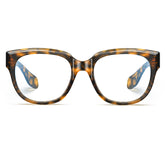How to Read Glasses Prescription

How to Read Glasses Prescription
Glasses prescription consists of a strange collection of numbers and words. Of course, these are glass-making instructions, but what exactly do they stand for? Here's a summary for you.
An eyeglasses prescription looks like this:

-
OD & OS
They are Latin abbreviations: OD (oculus dexter) means the right eye, OS (oculus sinister) means the left eye. You may also have a column labeled OU(oculus uterque), which means both eyes. -
SPH
SPH is short for sphere, which shows the amount of lens power needed to fix your vision. If the number is negative (–), it indicates nearsightedness (you find it difficult to see things far away). If the number is positive (+), it indicates farsightedness (you find it hard to see things close).
Lens power is measured in diopters. The higher the number, the stronger the prescription lenses required. For example, “−9.00 D” written under sphere means you are nearsighted and need a nine-diopter correction. Diopters may have decimals, such as 2.75 or 4.25. -
CYL
The cylinder number is how much astigmatism you have and the number can be negative or positive. Astigmatism is when the front part of your eye is shaped more like a football than a regular circle. A low number suggests your eyes are quite round while a higher number suggests your eyes are quite oval. There will be no figures written in the cylinder and axis columns if you do not have astigmatism. -
Axis
This number shows the position of the astigmatism on the cornea. It is written in degrees between 1 and 180—indicates which way the astigmatism lines up. This is for the lab to figure out how to place your lenses. -
ADD
This means the additional lens powers you need to focus at short distances. The near add is usually for near-vision work, such as reading. For example, some people over age 40 need to wear bifocals to correct presbyopia. The magnifying power is applied to the lower part of the lenses. For most people, ADD values are the same for both eyes. -
PD
PD is short for Pupillary distance. This is the distance between your eyes measured between your pupil center points. You need to ask your optician to add PD to your prescription for it helps to center lenses more accurately.

























